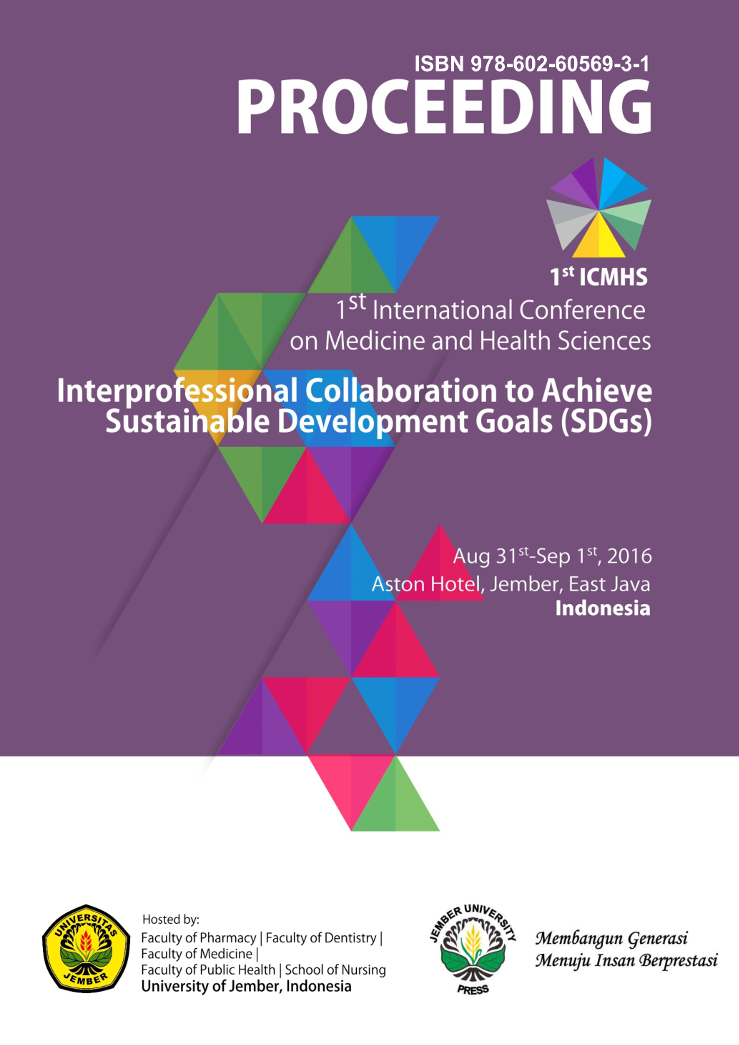DISASTER PREPAREDNESS AT PUBLIC HEALTH CENTER (PHC) BY SCORING ANALYSIS OF GENERAL ASPECTS, HEALTH CARE, SURVEILLANCE, ENVIRONMENTAL SANITATION AND LOGISTICS
Abstract
Preparedness according to the Constitution of
Indonesia No. 24 2007 on Disaster Management is a
series of activities done in order to anticipate
disasters through the organization as well as through
appropriate and useful activities. The disaster
management in Indonesia adopts the paradigm of
risk reduction, disaster management which aims to
improve the ability of communities to manage and
reduce the risk of disaster to society the disaster
subjects. This prevention is focused on pre-disaster
phase to minimize the risks (BNPB, 2009). Jember is
located at the altitude 0-3330 meters above the sea
level. Its area with the altitude of 100-500 meters
above the sea level is the largest area, 1240.77 km²
or 37.68% of total area of Jember. Meanwhile, the
narrowest area is the area with a height of over
2,000 meters above the sea level with 31, 34 km² or
0.95% of the area of Jember. Jember has a
topographic character of fertile plains canyon in the
Central and South parts and is surrounded by
mountains that extends to the boarder of East and
West. The area of South West has a plateau with a
height of 0-25 meters above the sea level, while the
Northeast area, which borders with Bondowoso, and
the Southeast area bordering Banyuwangi has over
1,000 meters above the sea level (PPSP 2012).
Based on the geographical conditions, the potential
disasters that may occur are such as, floods,
landslides and tsunami. The potential disaster is
influenced by Jember topography consisting of
plains, mountains, and beaches. The data from
Jember Health Department in 2011 showed that
there were 21 of 31 Districts potentially disaster may
happen.
When the disaster happens, it causes human
casualties and property losses. The human casualties
cause insecurity to the health status of affected
people and communities living around the disaster
area. Therefore, the acceleration of the handling of
the victim is not only necessary in emergency
response, but also it should be emphasized on the
prepared efforts carried out as early as possible, so
that the number of casualties can be minimized.
Preparedness is a shared responsibility of
stakeholders, central government, local
governments, communities and the business world.
The role has been written in constitution No. 24
2007 about Disaster Management.
One of the responsible stakeholders in implementing
preparedness activities is Public Health Center (PHC).
PHC functions as the central driver of health insight,
family and community empowerment center, and
the first level health care center which is qualified
and affordable. Especially, on the third function, it
includes aspects of public health and personal health
services including handling the emergency patient in
the community. (Community Health, Department of
Health, 2005).
Indonesia No. 24 2007 on Disaster Management is a
series of activities done in order to anticipate
disasters through the organization as well as through
appropriate and useful activities. The disaster
management in Indonesia adopts the paradigm of
risk reduction, disaster management which aims to
improve the ability of communities to manage and
reduce the risk of disaster to society the disaster
subjects. This prevention is focused on pre-disaster
phase to minimize the risks (BNPB, 2009). Jember is
located at the altitude 0-3330 meters above the sea
level. Its area with the altitude of 100-500 meters
above the sea level is the largest area, 1240.77 km²
or 37.68% of total area of Jember. Meanwhile, the
narrowest area is the area with a height of over
2,000 meters above the sea level with 31, 34 km² or
0.95% of the area of Jember. Jember has a
topographic character of fertile plains canyon in the
Central and South parts and is surrounded by
mountains that extends to the boarder of East and
West. The area of South West has a plateau with a
height of 0-25 meters above the sea level, while the
Northeast area, which borders with Bondowoso, and
the Southeast area bordering Banyuwangi has over
1,000 meters above the sea level (PPSP 2012).
Based on the geographical conditions, the potential
disasters that may occur are such as, floods,
landslides and tsunami. The potential disaster is
influenced by Jember topography consisting of
plains, mountains, and beaches. The data from
Jember Health Department in 2011 showed that
there were 21 of 31 Districts potentially disaster may
happen.
When the disaster happens, it causes human
casualties and property losses. The human casualties
cause insecurity to the health status of affected
people and communities living around the disaster
area. Therefore, the acceleration of the handling of
the victim is not only necessary in emergency
response, but also it should be emphasized on the
prepared efforts carried out as early as possible, so
that the number of casualties can be minimized.
Preparedness is a shared responsibility of
stakeholders, central government, local
governments, communities and the business world.
The role has been written in constitution No. 24
2007 about Disaster Management.
One of the responsible stakeholders in implementing
preparedness activities is Public Health Center (PHC).
PHC functions as the central driver of health insight,
family and community empowerment center, and
the first level health care center which is qualified
and affordable. Especially, on the third function, it
includes aspects of public health and personal health
services including handling the emergency patient in
the community. (Community Health, Department of
Health, 2005).
Downloads
Download data is not yet available.
Downloads
Published
2017-01-27
Issue
Section
General


